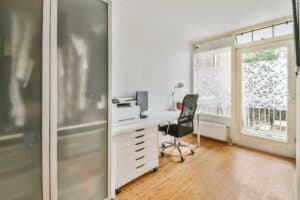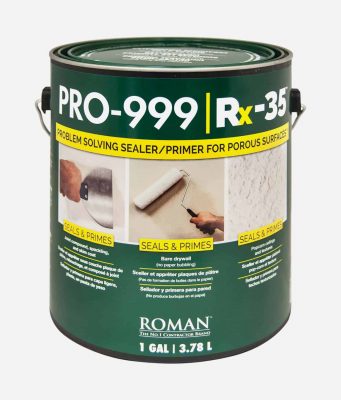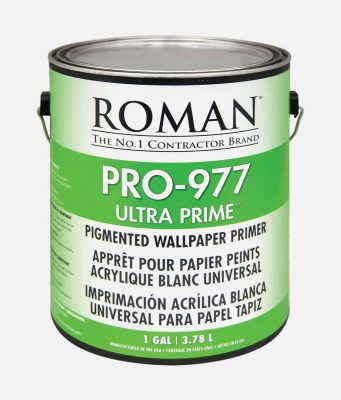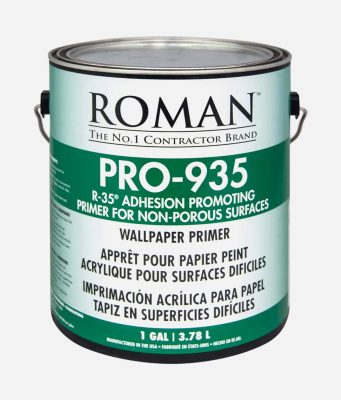Start by reading the manufacturer’s instructions that come with the wallpaper you purchased. They will provide step-by-step instructions on how to prepare your walls for the particular wallcovering you are working with and help you avoid the common pitfalls associated with the process.
Wall surfaces can vary in material, texture, and condition. A primer formulated to hang wallpaper on drywall will differ from one designed to promote adhesion on glass. No matter the surface, priming the wall before hanging will help you achieve a better installation. So why is that?
Priming Prepares Walls for Wallpaper
Priming helps wallpaper paste do its job. It is especially important when papering over difficult to adhere to surfaces like glass, tile, and paneling, or porous surfaces like bare drywall, joint compound, or chalky flat paint. If there is a problem or complaint about the installation later on, the first question will be, “How did you prep the walls?” Be sure you use the correct product for your surface type before you hang the paper.
Additionally, before applying a primer and installing your wallcovering, ensure that the wall is clean, dry and sound. Most wallpaper adhesives are water-based and any dirt, grease, or peeling paint can affect adhesion. If your wall surface is not in good condition, you may not get the proper adhesion which could ruin your papering project.
Before You Get Started: Do You Paint or Wallpaper First? You should definitely paint any areas that are close to where you are hanging your paper. That will prevent spills or splatters on your new wallpaper.
What Is Wallpaper Primer?
Sometimes referred to as a pre-wallpaper primer, the purpose of wallpaper primer is two-fold– to improve adhesion and make it easier to remove wallpaper when it’s time to redecorate. . You want the wallcovering to adhere well to the wall, but not so well that later removal is impossible.
Using Wallpaper Primers On Different Surfaces
Priming New Drywall
Make sure the surface is completely free of dust, grime, mildew or other contaminants. Ensure taped and mudded joints are sanded smooth and fully dry. Prime the new drywall with ROMAN Products PRO-977 Ultra Prime White Wallpaper Primer. It is formulated to dry to a durable, matte white finish that is ideal for new wallpaper. PRO-977 increases slip for easier installation and promotes wallpaper strippability when it’s time to redecorate.
Wallpapering Over Painted Walls
Wallpaper doesn’t adhere to your wall, rather, it sticks to your paint. So you must be certain the paint surface you papering over is sound. Test it with a wet sponge by holding the sponge on the paint for about 15 seconds and then scrubbing hard with a cloth. If very little comes off, the paint should be sound. If a large amount comes off, then the paint should be sanded or removed.
Also, check for good paint adhesion. Using a snap blade knife, cut a small
‘x’ into the paint and firmly press a piece of clear tape over the area. Then, quickly remove the tape. If nothing comes off then you probably have good adhesion. Paint that strips off with the tape indicates poor overall adhesion. Any loose paint will need to be removed before proceeding with wallpaper. Assuming you have a sound latex paint job, the best solution is Roman’s PRO-909 Vinyl Prep Clear Wallpaper Primer. It is acrylic, dries clear and cleans up with water.
Walls Where Old Wallpaper Has Been Removed
Before hanging your new paper, existing, old adhesive needs to be removed with a removal solution like ROMAN Products PRO-458 GEL WALLPAPER PASTE REMOVER. It comes in a handy spray bottle and breaks down old wallpaper residue quickly. Afterwards, wash the wall down with clean water, wipe dry, and prime the wall using ROMAN Products PRO-999 Rx-35 Sealer/Primer for Porous Surfaces. This clear primer seals drywall, joint compound, contractor flat paint, and old wallpaper paste residue.
Hanging Wallpaper on Sealed Wood, Glass, or Tile
Difficult to adhere to surfaces like glass, mirrors, ceramic tile, and sealed-wood paneling must be primed with an adhesion promoting primer before installation. The smooth, slick surfaces do not provide adequate “tooth” for wallpaper adhesive to grab the surface. For sealed surfaces, ROMAN recommends PRO-935 R-35 Adhesion Promoting Primer. This clear primer dries with a heavy residual tack, allowing wallpaper to be installed on sealed surfaces.
Do You Size A Painted Wall Before Papering?
The first thing you might be asking is: What is sizing?” Sizing is not measuring a wall, rather, it’s a method to prepare walls for wallpaper that predates modern primers. Most commonly, wall size is diluted wallpaper adhesive applied to the wall before installations. Though paperhangers have experimented with a variety of recipes to improve adhesion:

Sizing’s main purpose is to improve adhesion and to stop the wall from absorbing moisture out of the adhesive prematurely, allowing you to position the wallpaper before it dries. In most cases, when someone recommends sizing a wall, they are recommending priming. However, if you prefer the old school method, ROMAN’s TEKNABond Multipurpose Adhesive/Wall Size is available.
ROMAN – Premium Adhesives, Primers, and Removers
The best wallpaper project starts with top quality primers and adhesives and we carry the products that professionals demand. Proven through 75 years of proven experience, and backed by a knowledgeable customer service team, you can rest assured that you are buying the best wallpapering primers, adhesives, tools and accessories in the industry.
Whether you are a weekend warrior, wallpaper professional, architect, commercial property owner or retail establishment, we are available to assist you in selecting the right products for your job. Contact us today — we are here to help you!











